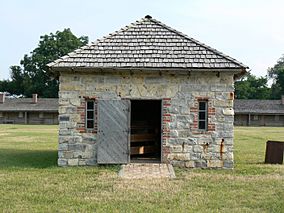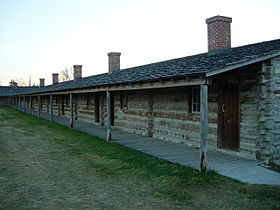Fort Atkinson (Nebraska) facts for kids
Quick facts for kids Fort Atkinson State Historical Park |
|
|---|---|

Powder magazine at Fort Atkinson
|
|
| Location | Fort Calhoun, Nebraska, United States |
| Area | 154.36 acres (62.47 ha) |
| Elevation | 1,073 ft (327 m) |
| Designation | Nebraska state historical park |
| Established | 1963 |
| Visitors | 40280 (in 2017) |
| Administrator | Nebraska Game and Parks Commission |
| Website | Fort Atkinson State Historical Park |
|
Fort Atkinson
|
|

Detail of (reconstructed) west rampart barracks
|
|
| Built | 1819 |
| NRHP reference No. | 66000454 |
| Significant dates | |
| Added to NRHP | October 15, 1966 |
| Designated NHL | July 4, 1961 |
Fort Atkinson was a very important place in early American history. It was the first United States Army post built west of the Missouri River. This area was part of the huge Louisiana Purchase that the U.S. bought. The fort was built in 1819 near what is now Fort Calhoun, Nebraska. It was used for about eight years before the army left it in 1827.
Today, this historic spot is called Fort Atkinson State Historical Park. It's also recognized as a National Historic Landmark. In the 1980s and 1990s, a copy of the original fort was built there.
The fort was more than just a military base. It was like the first town in Nebraska! Over 1,000 people lived there, including soldiers, traders, and trappers. It even had its own brickyard, a place to make lime, a stone quarry, and mills for grinding grain and cutting wood.
Contents
Lewis and Clark's Visit to Council Bluff
The spot where Fort Atkinson was later built had a special name: Council Bluff. This is not the same as the city of Council Bluffs, Iowa, which is about 20 miles south. In August 1804, the famous Lewis and Clark Expedition met with members of the Oto and Missouria Native American tribes at this bluff.
William Clark, one of the expedition leaders, thought this high bluff was a great place for a fort. It overlooked the Missouri River, making it a good defensive spot.
Building a Frontier Post: Fort Atkinson
Fifteen years after Lewis and Clark's visit, in 1819, President James Monroe sent a military group called the Yellowstone Expedition. Colonel Henry Atkinson led this group. Their mission was to build forts along the Missouri River. These forts would help American fur trade and reduce British influence in the northern plains.
The 6th US Infantry and 1st Rifle Regiments were part of this expedition. They arrived at Council Bluff on September 19, 1819. When they built Fort Atkinson, it became the first major American fort west of the Missouri River. It was also close to other private fur trading posts like Fort Lisa.
The soldiers first built a winter camp called Cantonment Missouri by the river. They had planned to build more forts further upriver, but they stopped and settled in for the winter. The winter of 1819–20 was extremely harsh. The soldiers didn't have enough supplies, which led to many becoming very sick from a lack of proper food. Sadly, over 200 of the 1,120 soldiers passed away that first winter. Many civilians also died, but their numbers were not recorded.
In the spring of 1820, the Missouri River flooded Cantonment Missouri. So, the soldiers moved their camp to the top of Council Bluff. They renamed it Fort Atkinson. The U.S. government maps called the area "Fort Calhoun" after the Secretary of War, John C. Calhoun. However, the army named the actual fort after its first commander, Colonel Atkinson. During the 1820s, soldiers at the fort even took weather observations for the government.
The fort's soldiers were only involved in a battle in 1823. Members of the Arikara tribe attacked a group of traders led by William H. Ashley in what is now South Dakota. Soldiers from Fort Atkinson went to get revenge by attacking the Arikara villages. No American soldiers died in this short fight. However, seven soldiers drowned on their way upriver when their boat hit a log. These soldiers were the first U.S. casualties in the Indian Wars on the Great Plains.
In 1827, the Army decided to close Fort Atkinson. The soldiers were sent to other places, mainly Fort Leavenworth.
Bringing Fort Atkinson Back to Life
Years later, in 1846, when the Mormons settled at Cutler's Park nearby, they found some old food supplies at the abandoned fort. By the 1850s, when more European-American settlers arrived, not much was left of the original fort.
In the 1950s, Nebraska State Historical Society archaeologists found where the old buildings of Fort Atkinson once stood. The Nebraska Game and Parks Commission took over the site in 1963. During the 1980s and 1990s, they rebuilt the fort to look like it did long ago.
Today, Fort Atkinson is a Nebraska state historical park. It has a military museum where you can learn about its past. It was recognized as a National Historic Landmark in 1961 because of its importance.
You can visit the park and see "living history" demonstrations. These happen on the first weekend of each month from May to October. People dress up in old clothes and show what life was like at the fort. They demonstrate crafts, show what an Indian agent did, and act out the activities of the soldiers from the Sixth Regiment of United States Infantry and First Regiment of United States Riflemen. It's like stepping back in time!
See also



